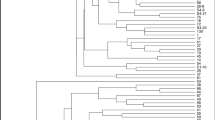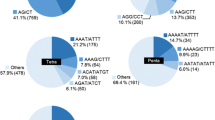Abstract
Boehmeria nivea (ramie), a subshrub of the Urticaceae family and an important fiber crop, has been grown in Asian countries, including Korea, for many centuries. Traditionally, in some regions of Korea, ramie leaves are also used as a major ingredient in ‘Songpyeon’ rice cakes. Despite its economic importance, the molecular genetics of ramie have not yet been studied in detail. Researchers from Yeong-Gwang Agricultural Technology Center collected genetic resources of ramie from a variety of local sites in Korea. Nuclear internal transcribed spacer sequences amplified from 90 genetic resources showed no variation in size or sequence between them or B. nivea reference samples, indicating that all the genetic resources could be taxonomically classified as B. nivea. To systematically and efficiently manage these genetic resources, we developed simple sequence repeat (SSR) markers for ramie using the magnetic bead hybridization selection method. Finally, we selected 17 SSR markers that showed possible polymorphism among the genetic resources and analyzed the genetic diversity of ramie collection. These 17 markers detected a total of 140 alleles, ranging from 3 to 17 alleles per accession. The average genetic diversity value was 0.61, ranging from 0.37 to 0.84. Average polymorphism information content was 0.56, ranging from 0.34 to 0.82. Genetic cluster analysis based on SSR data revealed that the genetic collection of ramie plants could be classified into four distinct clusters. A purity test on several of the genetic resources using polymorphic SSR markers revealed that some resources were impure. These newly developed SSR markers might be useful for diverse genetic analysis including the management of genetic collections, establishment of core collections, and cultivar identification.
Similar content being viewed by others
Literature Cited
Chang JM, Huang KL, Yuan TT, Lai YK, Hung LM (2010) The anti-hepatitis B virus activity of Boehmeria nivea extract in HB Vviremia SCID mice. Evid Based Complement Alternat Med 7:189–195
Conesa A, Gotz S, Garcia-Gomez JM, Terol J, Talon M, Robles M (2005) Blast2GO: a universal tool for annotation, visualization and analysis in functional genomics research. Bioinformatics 21:3674–3676
Costion C, Ford A, Cross H, Crayn D, Harrington M, Lowe A (2011) Plant DNA barcodes can accurately estimate species richness in poorly known floras. PLoS ONE 6:e26841
Doyle J (1991) DNA protocols for plants. Molecular Techniques in Taxonomy NATO ASI Series 57:283–293
Ellis JR, Burke JM (2007) EST-SSRs as resource for population genetic analyses. Heredity 99:125–132
Glenn TC, Schable NA (2005) Isolating microsatellite DNA loci. Methods Enzymol 395:202–222
Huang KL, Lai YK, Lin CC, Chang JM (2006) Inhibition of hepatitis B virus production by Boehmeria nivea root extract in HepG2 2.2.15 cells. World J Gastroenterol 12:5721–5725
Jie Y, Zhou Q, Chen P (2002) Genetic relation analysis of ramie cultivars with RAPD marker. Acta Agronomica Sinica 28:254–259
Kalia RK, Rai MK, Kalia S, Singh R, Dhawan AK (2011) Microsatellite markers: an overview if the recent progress in plants. Euphytica 177:309–334
Kim CH (2007) Urticaceae. In CW Park, ed, The Genera of Vascular Plants of Korea. Flora of Korea Editorial Committee, Seoul, Korea, pp 258–261
Kim SC, Uhm YK, Ko S, Oh CJ, Kwack YB, Kim HL, Lee Y, An CS, Park PB, Kim HB (2015) KiwiPME1 encoding pectin methylesterase is specifically expressed in the pollen of a dioecious plant species, kiwifruit (Actinidia chinensis). Hortic Environ Biotechnol 56:402–410
Kim SH, Sung MJ, Park JH, Yang HJ, Hwang JT (2013) Boehmeria nivea stimulates glucose uptake by activating peroxisome proliferatoractivated receptor gamma in C2C12 cells and improves glucose intolerance in mice fed a high-fat diet. Evid Based Complement Alternat Med Article ID 867893. doi:10.1155/2013/867893
Kim SI, An MJ, Han YS, Pyeun JH (1993) Sensory and instrumental texture properties of rice cakes according to the addition of songpy (pine tree endodermis) or mosipul (china grass leaves). J Korean Soc Food Sci Nutr 22:603–610
Kim SM, Shin DI, Song HS, Kim SK, Yoon ST (2006) Geographical distribution and habitat characteristics of Boehmeria in South Korea. Korean J Medicinal Crop Sci 14:14–18
Kimura M (1980) A simple method for estimating evolutionary rates of base substitutions through comparative studies of nucleotide sequences. J Mol Evol 16:111–120
Lee AY, Wang X, Lee DG, Kim YM, Jung YS, Kim HB, Kim HY, Cho EJ, Lee S (2014) Various biological activities of ramie (Boehmeria nivea). J Appl Biol Chem 57:279–286
Liang S (2009) A phylogenetic study of the genus Boehmeria in Korea. M.Sc. Thesis, Yeungnam University
Li CI, Chiou SJ, Tong TS, Lee CY, Lee LT, Cheng CM (2010) Development and validation of molecular markers for characterization of Boehmeria nivea var. nivea and Boehmeria nivea var. tenacissima. Chin Med 5:40
Lin CC, Yen MH, Lo TS, Lin CF (1997) The antiinflammatory and liver protective effects of Boehmeria nivea and B. nivea subsp. nippononivea in rats. Phytomedicine 4:301–308
Lin CC, Yen MH, Lo TS, Lin JM (1998) Evaluation of the hepatoprotective and antioxidant activity of Boehmeria nivea var. nivea and B. nivea var. tenacissima. J Ethnopharmacol 60:9–17
Liu KJ, Muse SV (2005) PowerMarker: an integrated analysis environment for genetic marker analysis. Bioinformatics 21:2128–2129
Liu LJ, Meng ZQ, Wang B, Wang XX, Yang JY, Peng DX (2009) Genetic diversity among wild resources of the genus Boehmeria Jacq. from west china determined using inter-simple sequence repeat and rapid amplification of polymorphic DNA markers. Plant Prod Sci 12:88–96
Liu T, Zhu S, Fu L, Tang Q, Yu Y, Chen P, Luan M, Wang C, Tang S (2013) Development and characterization of 1,827 expressed sequence tag-derived simple sequence repeat markers for ramie (Boehmeria nivea L. Gaud). PLoS ONE 8:e60346
Metzgar D, Bytof J, Wills C (2000) Selection against frameshift mutations limits microsatellite expansion in coding DNA. Genome Res 10:72–80
Michener CD, Sokal RR (1957) A quantitative approach to a problem of classification. Evolution 11:490–499
Nho JW, Hwang IG, Kim HY, Lee YR, Woo KS, Hwang BY, Chang SJ, Lee J, Jeong HS (2010) Free radical scavenging, angiotensin I-converting enzyme (ACE) inhibitory, and in vitro anticancer activities of ramie (Boehmeria nivea) leaves extracts. Food Sci Biotechnol 19:383–390
Ranocha P, Denancé N, Vanholme R, Freydier A, Martinez Y, Hoffmann L, Köhler L, Pouzet C, Renou JO, Sundberg B, et al (2010) Walls are thin 1 (WAT1), an Arabidopsis homolog of Medicago truncatula NODULIN21, is a tonoplast-localized protein required for secondary wall formation in fibers. Plant J 63:469–483
Seo KI, Lee GS, Park SG, Yoon MS, Ma KH, Lee JR, Choi YM, Jung Y, Lee MC (2012) Genome shotgun sequencing and development of microsatellite markers for gerbera (Gerbera hybrid H.) by 454 GS-FLX. African J Biotechnol 11:7388–7396
Shaw J, Lickey EB, Schilling EE, Small RL (2007) Comparison of whole chloroplast genome sequences to choose noncoding regions for phylogenetic studies in angiosperms: the tortoise and the hare III. Amer J Bot 94:275–288
Sung MJ, Davaatseren M, Kim SH, Kim MJ, Hwang JT (2013) Boehmeria nivea attenuates LPS-induced inflammatory markers by inhibiting p38 and JNK phosphorylations in RAW264.7 macrophages. Pharm Biol 51:1131–1136
Tamura K, Peterson D, Peterson N, Stecher G, Nei M, Kumar S (2011) MEGA5: molecular evolutionary genetics analysis using maximum likelihood, evolutionary distance, and maximum parsimony methods. Mol Biol Evol 28:2731–2739
Varshney RK, Graner A, Sorrells ME (2005) Genic microsatellite markers in plants: features and applications. Trends Biotechnol 23: 48–55
Wang ML, Barkely NA, Jenkins TM (2009) Microsatellite markers in plants and insects. Part I: applications of biotechnology. Genes Genom Genomics 3:54–67
Wei J, Lin L, Su X, Qin S, Xu Q, Tang Z, Deng Y, Zhou Y, He S (2014) Anti-hepatitis B virus activity of Boehmeria nivea leaf extracts in human HepG2.2.15 cells. Biomed Rep 2:147–151
Xu QM, Liu YL, Li XR, Li X, Yang SL (2011) Three new fatty acids from the roots of Boehmeria nivea (L.) Gaudich and their antifungal activities. Nat Prod Res 25:640–647
Yeh FC, Yang R, Boyle T (1999) POPGENE Version 1.32. Microsoft window-based free ware for population genetic analysis. Computer program and documentation distributed by University of Alberta and Centre for International Forestry Research, Alberta, Canada
Yu JK, Dake TM, Singh S, Benscher D, Li W, Gill B, Sorrells ME (2004) Development and mapping of EST-derived simple sequence repeat markers for hexaploid wheat. Genome 47:805–818
Zane L, Bargelloni L, Patarnello T (2002) Strategies for microsatellite isolation: a review. Mol Ecol 11:1–6
Zhao W, Lee GA, Kwon SW, Ma KH, Lee MC, Park YJ (2012) Development and use of novel SSR markers for molecular genetic diversity in Italian millet (Setaria italica L.) Genes Genom 34:51–57
Zhou J, Jie Y, Jiang Y, Zhong Y, Liu Y, Zhang J (2005) Development of simple sequence repeats (SSR) markers of ramie and comparison of SSR and inter-SSR marker systems. Prog Nat Sci 15:137–142
Author information
Authors and Affiliations
Corresponding author
Additional information
These authors contributed equally to this work.
Rights and permissions
About this article
Cite this article
Kim, H.B., Uhm, Y.K., Kim, J.J. et al. Development of novel simple sequence repeat markers from ramie (Boehmeria nivea L. Gaudich) and analysis of genetic diversity in its genetic resources. Hortic. Environ. Biotechnol. 57, 519–528 (2016). https://doi.org/10.1007/s13580-016-0094-9
Received:
Revised:
Accepted:
Published:
Issue Date:
DOI: https://doi.org/10.1007/s13580-016-0094-9




